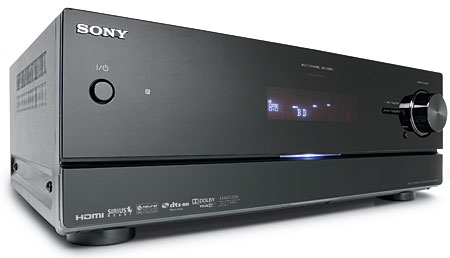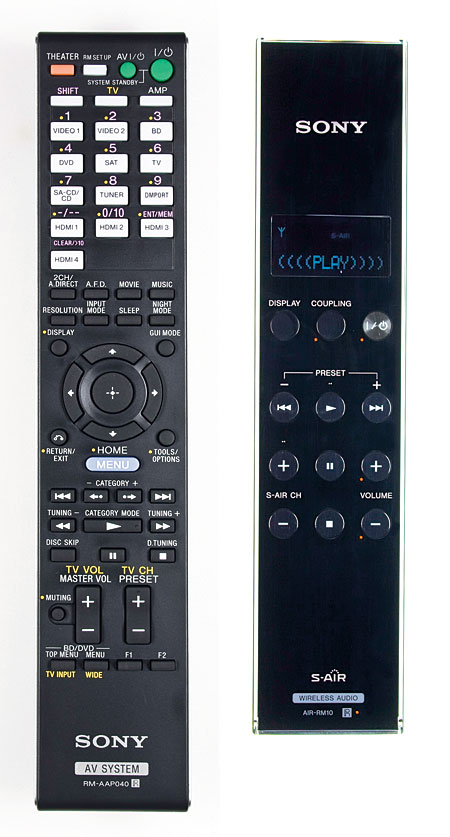Sony STR-DN1000 A/V Receiver Page 2
Obsessed, in Dolby TrueHD, is largely a vehicle for Beyoncé, who plays her part in this Fatal ttraction–like scenario with aplomb—especially in the action-packed finale. Until that point, the plot mainly focuses on the hus- band, well played by the charismatic Idris Elba, who is pursued by an increasingly determined stalker. Well-recorded piano and strings fret around the edges and take on more tragic overtones as the story progresses. The Sony handled these elements well. In an office-party scene, the bass line should have pounded a little harder. However, I later discovered that the receiver’s dynamic range control was set to Auto, which I defeated.

Last Chance Harvey, in Dolby TrueHD, may shock younger viewers with its insistence that people who are considerably older than Beyoncé have feelings and emotions too. Emma Thompson and Dustin Hoffman play this autumnal romance at perfect pitch, neither low-key nor overwrought. However, the score is a bit more placid than the performances. Only when a bit of rockabilly breaks out along the Thames does the music hint at what the characters are really feeling. The Sony handled everything gracefully.
Dolby Pro Illogic
As movies gave way to music, I made an interesting discovery. The STR-DN1000 apparently doesn’t include the Dolby Pro Logic II/IIx Music mode—only the Movie mode. Since I typically use both stereo and DPLII Music during audio-only demos, this came as a surprise. I’ve reviewed HTIB systems without DPLII, but this is the first time I’ve done without its Music mode in a mainstream A/V receiver from a major manufacturer. Was Sony trying to save a penny by not licensing the full DPLII suite? Or was this a conscious attempt to drive listeners to other modes?
Alternatives in this product include DTS Neo:6, present in both its Movie and Music modes, and what is identified as the Neural-THX mode, although Neural was recently acquired by DTS. At a recent trade show, I asked the DTS people how they plan to position Neo:6 versus Neural. They said Neo:6 would be for high-end applications, while Neural would be for low-bit-rate uses. Until now, Neural’s primary use has been in XM satellite radio, but it has spread to several A/V receiver models lately as an all-purpose surround rechanneling mode. In any case, when I needed stereo-to-surround transformation, I concentrated on the Neo:6 Music mode, as opposed to Neural and the usual DSP junk modes. When I’ve directly compared the DPLII and DTS Neo:6 Music modes in the past, I’ve found that DPLII better preserves the feel of the original stereo mix, while Neo:6 provides a wetter effect, with more reverb.
Nonetheless, I haven’t used Neo:6 in a long time, and I approached it with an open mind. It did well in the Camerata Köln’s CD of Bach’s Trio Sonatas. This chamber group is dominated by two flutists and various stringed instruments. As many historically conscious groups do these days, they play with little or no vibrato, in an effort to leave behind the conventions of a Romantic-era performance. This can lead to thin-sounding recordings. However, in this CPO release, the engineers of Deutschlandfunk did an excellent job of lacquering the soundstage with just the right amount of reverb. It worked well in stereo and even better in Neo:6—the latter added reverb, but not to excess.

Art Blakey’s Jazz Messengers with Thelonious Monk, on vinyl, documents the collaboration of two jazz greats and focuses on Blakey’s band and Monk’s compositions. It was recorded with little reverb. Nonetheless, Neo:6 shoved a lot of the bandleader’s drum kit into the surround speakers, presumably because it was thickened with out-of-phase sound. DPLII probably would have done the same. The only alternative was stereo. Spatially, it placed the tenor sax in front, Monk’s stimulating piano slightly behind, and Blakey’s drums—despite their prominence in the mix—further behind. A memorable trumpet solo by Bill Hardman conjured a strong center image even with just two speakers.
This Year’s Model is Elvis Costello’s second LP and his first with the Attractions. What a difference a first-class band makes. Nick Lowe’s production achieves a big, open sound. The powerful rhythm section always grabs me by the throat no matter what equipment I use. The bass and drums were strong enough to punch through the AVR’s slightly lightweight low-frequency presentation. Costello’s outrage at the manipulative mass media in “Radio Radio” is evergreen and transcends mere politics: “They say you’d better listen to the voice of reason, but they don’t give you any choice because they think that it’s treason.”
Adventure With Wireless Speakers
The STR-DN1000 AVR can work with either of two wireless speakers. The AIR-SA50R measures 10 inches wide by 5 high by 4 deep. It sells for $250, but as with the other products below, you may find a better price at sonystyle.com. It is a single unit with two 2.54-inch internal drivers, touch-sensitive controls on the front, and a wall-wart power supply. In addition to its wireless capability, it has an auxiliary input to connect to the analog output of an external device. It also has a small backlit liquid crystal display that unfortunately remains lit even when the unit is in standby mode.





























































